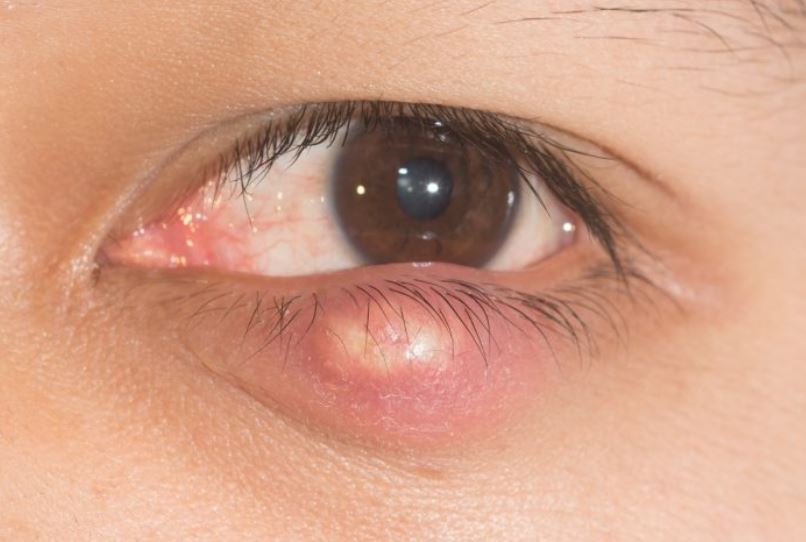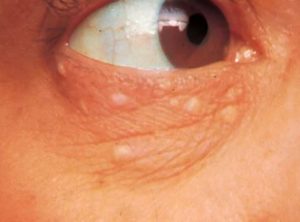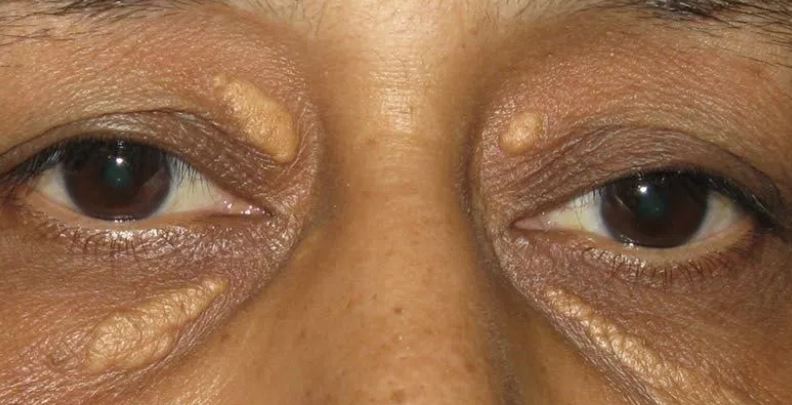In most cases, the appearance of white spots under the eyes is usually associated with milia. However, it is important to note that there are other factors that can lead to the development of white spots under eyes. Here, we will cover some of these causes and possible treatment options.
Chalazia (chalazion)
Table of content
The appearance of white bumps on the eyelid may be due to clogging up of the pores as a result of sweat build-up. Chalazion is a condition that results from the blockage of the meibomian gland orifices (the glands under the eyelids), and blockage of sebaceous secretions. The bumps appear on the eyelids and can also lead to eyelid swelling, redness, and pain.
Acute Chalazia can be handled at home using various techniques and remedies. For instance, applying a hot compress on the area. Chronic chelazia can be treated using intralesional corticosteroid, surgical drainage, and curettage.

Syringoma

Syringoma is a common, yet benign tumor that affects the sweat glands. This condition results in the appearance of tiny bumps under the eyes. These bumps are either yellow or skin-colored. About 20% of the conditions reported develop around the eyelids. Also, the condition is common among women, compared to men.
The appearance of syringoma is usually associated with genetics. However, the condition is also associated with Down’s syndrome, and diabetes mellitus. The bumps are benign and therefore no treatment is required. On the other hand, if you wish to remove them you can opt for laser treatment, cryotherapy, electrodessication and curettage.
Styes, moles (nevi), or acne
Acne or moles can have the appearance of tiny white bumps under the eyes. Pimples occur due to the pore blockage by the sebum produced in the skin. On the other hand, moles can occur under the eyes as a result of clustering of melanocytes in that affected area. Sometimes moles start off as very small bumps that become bigger in time.
The appearance of pimples under the eyes is common among people with acne-prone skin. Women are at high risk of developing acne under the eyes particularly during pregnancy, menstruation, or as a result of stress.
Styes on the other hand appear as a single lump on the eyelid. This lump is as a result of an infection caused by staphylococcus bacteria.
It is important to get examined by a dermatologist to determine the exact cause of the bumps under the eye, or around the eyelid. A proper diagnosis will help determine the right treatment option. For instance, if it is a mole, then the treatment option includes surgery, microdermabrasion, glycolic or salicylic acid peels.
Xanthelasma (cholesterol deposits).
This is a condition that results from cholesterol build-up under the skin. The term is derived from the Greek term “Xanthos” which means “yellow” and “elasma” which means “beaten metal plate” (Hampton et al,). This is because the lesions appear as small, yellow-like bumps around the eyelid area. The condition has been linked to obesity, hyperlipemia, cardiovascular changes, and hypercholesteremia.

Treatment options for xanthelasma include dietary changes, laser treatment, surgical excision, Electrodesiccation and cryotherapy.
Sebaceous Hyperplasia
This condition results from an abnormal functioning of the sebaceous glands. These lesions develop due to overgrown glands that get blocked by oil build-up. The bumps look like whiteheads but they do not respond to topical acne treatments. The cause of these bumps is generally inked to genetics. There people who are likely to develop these bumps particularly after the age of 40, and have a family history of the condition. Furthermore, dermatologists believe that sunburn can trigger the appearance of these bumps.
The classic appearance of sebaceous hyperplasia is whitish-yellow, or skin-colored.
Treatment options for sebaceous hyperplasia include cryosurgery and electrodessication. Alternatively, there are home remedies that you can try to reduce the bumps.
There are other factors that can cause white spots under eyes. They include rosacea, sun damage, and cosmetics. It is important to go for a check-up to determine the exact cause of the bumps. In most instances, the bumps are due to milia. Milia affects millions of people In the U.S. Alternatively, a disruption in the functioning of the sebaceous glands can trigger the appearance of bumps around the eye area.
If the bumps are itchy, then the likely causal factor may be molluscum contagiosum.References:
- https://www.skintour.com/skin-problems-diseases/moles-lumps-and-bumps-on-skin-and-face/
- http://dermgroup.net/blog/sebaceous-hyperplasia-treatment-management/
- https://emedicine.medscape.com/article/1212709-treatment#d7
